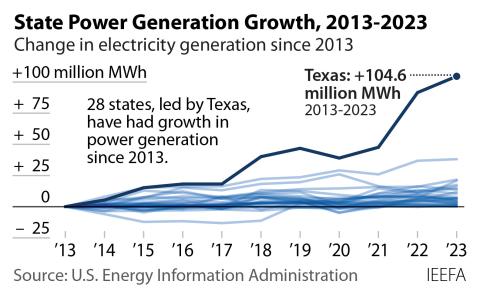IEEFA update: High-risk Navajo acquisition of Montana-Wyoming mines isn’t a done deal
Executives at Navajo Transitional Energy Company (NTEC) are presenting their proposed acquisition of Cloud Peak Energy as a done deal, but it may still need the financial backing of the Navajo Nation to cover hundreds of millions of dollars in bonding liabilities.
And NTEC has yet to present a persuasive business case for the acquisition, choosing instead to publish unrealistic production projections in hopes evidently of gaining support for a deal that poses a serious financial threat to Navajo Nation interests.
Deal Still Requires $408 Million in Bonding
Surety companies that are being asked to underwrite $408 million in bond placements required to close the proposed NTEC purchase of Cloud Peak’s coal mines in Montana and Wyoming will want—as a matter of course—to be confident that NTEC is good for that commitment. NTEC, a tiny company that owns a small coal mine and a small fraction of a power plant in New Mexico, may not have the financial muscle to meet such a requirement on its own.
That would force NTEC to ask the Navajo Nation to step in and provide a surety backstop (Navajo Nation is the owner and sole shareholder of NTEC). If NTEC is wrong about its rosy projections and runs into financial trouble, the bond companies will turn to the Navajo Nation to pay them.
NTEC Has Not Been Transparent With Navajo Leadership
NTEC’s behavior toward Navajo leaders has been detailed in assorted news articles over the past couple of weeks noting, for instance, that the Navajo Nation was not consulted on the acquisition, even though the deal contradicts Navajo policy that emphasizes investment in renewable energy over fossil fuels.
Navajo Nation lawyers have been barred from attending closed-door sessions on the deal, and NTEC executives have insisted that tribal representatives—if they want to know what’s going on—come to them at their off-reservation offices 110 miles away, rather than the other way around.
The bottom line is that NTEC is seeking to seal a deal that will leave the Navajo people owning a bankrupt set of mines in a declining sector of the energy industry.
It’s only fair to point out, too, that NTEC’s three top executives have longstanding ties to the coal industry and have decided to focus the mission of NTEC solely on owning coal mines, rather than on developing other forms of energy.
NTEC’s Public Relations Campaign Minimizes Risk
NTEC has commissioned and disseminated a report that paints the mine acquisitions as a sensible move.
The report is by the same group (Energy Ventures Analysis) that last year put out a study saying it would be a good idea for the Navajo Nation to take over ownership of Kayenta Mine and Navajo Generating Station. Peabody Energy, which owns Kayenta, ran that campaign, one meant to convince the Navajo Nation to buy the failing coal-fired generation complex (Navajo leaders wisely voted down the proposal).
The new report—like EVA’s material on NGS and Kayenta—relies on several questionable assertions:
- Coal production in the Powder River Basin, which is where Cloud Peak operates, will level off at 250 million tons annually through 2035.
This projection ignores the persistent trend of coal-fired power plant closures across the country alongside huge market gains for gas-fired, wind, and solar generation. These trends spell lasting trouble in the Powder River Basin (see our March report, Powder River Basin Is in Long-Term Decline.)
- The rate of coal-fired plant retirements has slowed or stabilized.
In fact, of the 14,000MW of coal-fired power capacity retiring in 2019, 9,000MW were announced in just the past 12 month, which suggests reliance on current announcements alone almost certainly understates how much of the coal market will be lost in the years ahead. Another indicator of collapse across the coal sector: Capacity factors, which measure how often coal plants are actually running, are tanking industry-wide. A recently published IEEFA report details how coal use has rapidly disappeared over the past 10 years, for instance, across nine southeastern states, a trend that will persist as gas and renewables take more market share (see Coal-Fired Power Generation Across Southeast U.S. in Freefall).
- “As supply and demand return to balance, company profitability should return to historical levels” and that “margins should return to $2 per ton as excess capacity is reduced.”
To date, little or no production has actually been reduced in the Powder River Basin, and supply continues to far exceed demand, creating a chronic oversupply situation that continues to suppress profit margins, a circumstance that favors larger and financially stronger competitors.
- A preference among Powder River Basin customers to buy from more than one producer is advantageous to Cloud Peak.
While customers do prefer to diversify their supplier portfolio, they also likely have grown hesitant to do business with the financially weakest companies because of the risk of unexpected interruptions in deliveries of coal.
- Asian markets offer the promise of Cloud Peak recovery.
Export markets for U.S. coal producers are extremely challenging. When coal prices are low, the high cost of rail transportation to distant West Coast ports means companies like Cloud Peak cannot compete with producers closer to Asia.
While Cloud Peak under NTEC would be starting anew with a relatively clean financial slate, NTEC does not have pockets deep enough to weather any adversity. That, combined with the possibility that NTEC doesn’t have the resources to meet the deal’s bonding requirements without the backing of the Navajo Nation and the absence of a defensible business case, means Navajo wealth is being imprudently placed at risk.
Karl Cates [email protected] is an IEEFA research editor.
Seth Feaster [email protected] is an IEEFA data analyst.
RELATED POSTS:












